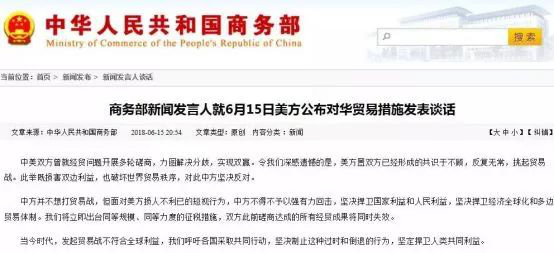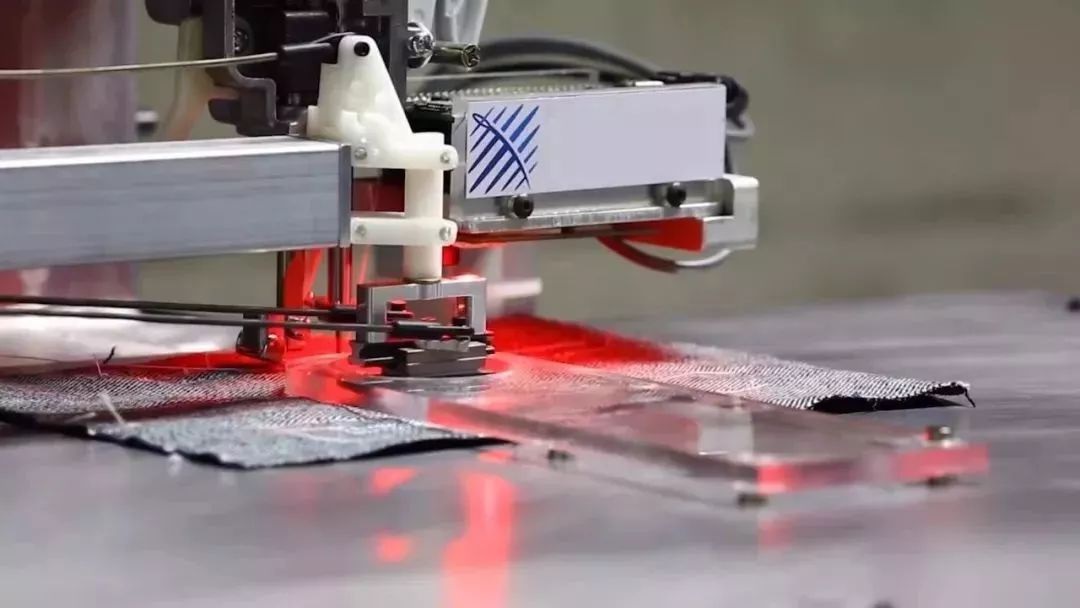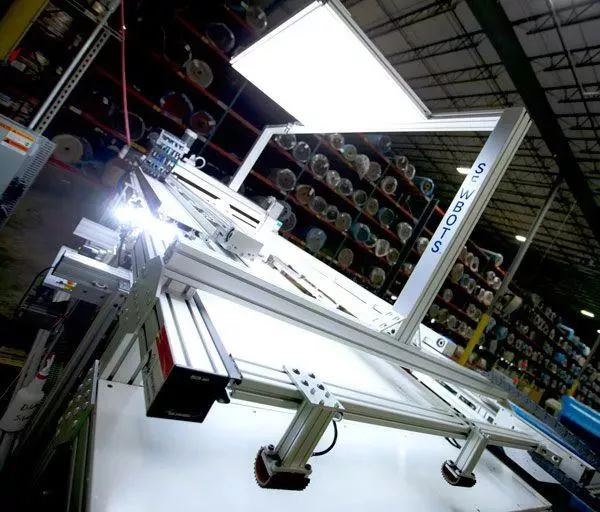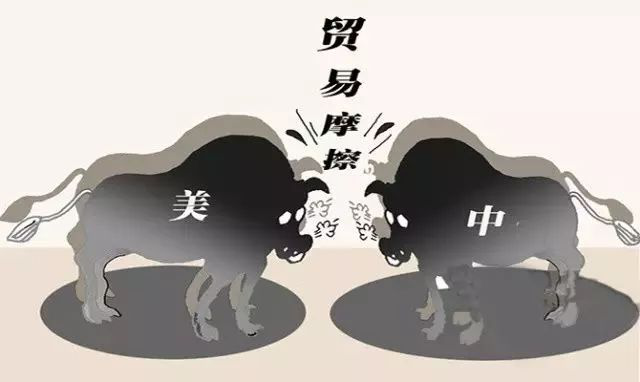The Sino-U.S. trade war has started and the U.S. announced its full support for the "clothing production" policy. How does China's textile industry move?
- Categories:Industry News
- Author:
- Origin:
- Time of issue:2018-06-20
- Views:18
(Summary description)The U.S. government has released a list of goods subject to tariff increases, and will impose an additional 25% tariff on approximately US$50 billion imported from China.
The Sino-U.S. trade war has started and the U.S. announced its full support for the "clothing production" policy. How does China's textile industry move?
(Summary description)The U.S. government has released a list of goods subject to tariff increases, and will impose an additional 25% tariff on approximately US$50 billion imported from China.
- Categories:Industry News
- Author:
- Origin:
- Time of issue:2018-06-20
- Views:18
June 15, 2018
The U.S. government has released a list of goods subject to tariff increases, and will impose an additional 25% tariff on approximately US$50 billion imported from China. The 50 billion commodity list includes 1,102 products, including those related to the Made in China 2025 strategic plan, to dominate the emerging high-tech industries that will promote China's future economic growth. Among them, about 34 billion U.S. dollars of goods have been imposed on July 6, 2018, and the additional tariffs on about 16 billion U.S. dollars have begun to solicit public opinions. At the same time, it began to solicit public opinions on additional tariffs on approximately US$16 billion in goods. At the same time, it began to solicit public opinions on additional tariffs on approximately US$16 billion in goods.
June 15 at 8 PM
In response to the US's act of imposing 25% tariffs on 50 billion US dollars of Chinese goods, the Ministry of Commerce of my country stated at 8 pm on June 15th:

1 China and the United States have conducted multiple rounds of consultations on economic and trade issues in an attempt to resolve differences and achieve a win-win situation. What China deeply regrets is that the U.S. ignored the consensus reached by the two sides, and it was erratic and provoked a trade war. This action not only harms bilateral interests, but also undermines the world trade order. China firmly opposes this.
2 my country’s Ministry of Commerce stated that China does not want to fight a trade war. However, in the face of the short-sighted behavior of the United States that harms others, China has to fight back strongly, resolutely defending national and people’s interests, and resolutely defending economic globalization and the multilateral trading system.
3 my country's Ministry of Commerce pointed out that China will immediately introduce taxation measures of the same scale and intensity, and all the economic and trade results reached by the two parties will be invalidated at the same time.
4 my country’s Ministry of Commerce stated that in this era, it is not in the global interest to initiate a trade war. China calls on all countries to take joint actions to resolutely stop this outdated and retrogressive behavior and firmly defend the common interests of mankind.
5. The Ministry of Commerce of the People's Republic of my country announced that it will conduct a periodical review of dumping and dumping margins for anti-dumping measures applicable to imports of related high-temperature and pressure-bearing alloy steel seamless steel pipes originating in the United States and the European Union.

Early morning of June 16
Immediately after the Ministry of Finance issued an announcement in the early morning of the 16th: The State Council’s Tariff Commission decided to impose 25% tariffs on 659 items of approximately US$50 billion originating in the United States, and announced the list of products subject to additional tariffs.

To put it simply, China does not pick things up, but if the United States strikes a punch, China will definitely strike back with the same punch, at the same time and with the same weight. In the past month, the slightly calm Sino-US trade relationship has revived. And this time, it's going to be a real sword and a real gun.
There is no doubt that this is a battle imposed on China; but China’s such a tough counterattack is indeed remarkable. At least four interesting observation points:
1, the same scale. The United States is aiming at US$50 billion in Chinese goods. I’m sorry, but China will counter-attack you with US$50 billion in US goods. China is not scared, it is also not to be indecent.
2, the same strength. The United States wants to impose an additional tariff of 25%, and China is also welcome. These listed American products will also be subject to an additional 25% of Chinese tariffs. China does not cause trouble, but it is not afraid of trouble.
3. Thunder strikes. In just 6 hours, the detailed counter-attack list was made public; at the same time, it was announced that all the results of the consultations were blown away. The Chinese side should be fully aware of it and respond calmly.
4. Stand up for battle. According to US media reports, in retaliation for China’s counterattack, the US has drawn up a second list involving Chinese goods. However, people familiar with the matter also revealed to the author that China has also drawn up a counter-attack list of American products of the same scale. Since the United States is going to fight, then we will stay with you to the end.
In the list, the commodities subject to tariffs on July 6 include uncarded cotton and cotton linters.


So far, this Dragon Boat Festival, the Sino-US trade war can be described as a full-scale war!
On the same day, analysts pointed out that although the US does not directly involve the textile and apparel industry in the field of taxation on China. However, the textile and garment industry is a labor-intensive industry that can solve many jobs. Although Trump would like to invite this industry back to the United States, but helplessly, the US textile and apparel industry is shrinking, labor costs are too high, and the possibility of returning to the United States in the short term is low.
Therefore, once the Sino-US trade war reignites, the United States will definitely increase the tariffs on textiles and clothing to deal with China. It is largely a matter of time.
It's not surprising ▼
Also on this day, June 16, New York announced the implementation of a comprehensive clothing production support policy plan in the Garment District, a traditional clothing industry district in Manhattan. ——What does this plan mean in the context of the Sino-US trade war?
The United States announced a comprehensive support for the "clothing production" policy!
The plan follows the recommendations of the Garment District Steering Committee, and the supporting policies proposed include:
A new tax incentive plan (IDA plan) to protect the manufacturing space here;
Support the acquisition of a building dedicated to clothing production here through public-private partnership;
Set up special permits to restrict hotel development in the area;
A proposal for a zoning change plan that will have a positive impact on clothing production in the neighborhood (the proposal has been opened for public review on June 11).
Gale Brewer said: “The ecosystem of skilled workers and professional suppliers in the apparel industry are concentrated in the Garment District, which is the cornerstone of New York’s fashion industry.”
The Garment District IDA plan is a tax incentive plan of the New York City Industrial Development Agency (NYCIDA). The plan will allow owners to rent houses to fashion production companies for a long time, including manufacturers in the fashion supply chain such as plate making, embroidery, printing, and dyeing. . The lease term of the house can be as long as 15 years, and the maximum total rent per square foot is $35 (including utilities and other expenses). In return for participating in the IDA program, the owner will receive discretionary tax incentives from NYCIDA.
In addition to the IDA plan, the de Blasio government also promised to provide the Garment District with US$20 million in funding to facilitate the acquisition of a building used for clothing production in the area. It is reported that this building will be used as a dedicated production space and will be jointly operated and managed with non-profit organizations in the form of public-private cooperation.
Europe and the United States regained the clothing manufacturing industry and trained clothing workers in their own countries
Apparel retailers in Europe and the United States measure each of the reasons for rising costs: raw material prices, protracted customs procedures and unreliable energy supply, unstable management quality, industrial or political turmoil, ethical health and safety regulations, and fluctuations in oil prices. The cost of transportation and the impact on the environment... All these factors increase the offshore cost of clothing and extend the time for clothing production.
In fact, after the financial crisis, developed economies are reviewing and revising the old strategies of "de-industrialization" and "de-manufacturing". "Re-industrialization" has become a common strategic choice of many developed countries. Influential retailers and brand owners are also actively seeking to develop manufacturing bases closer to the consumer market. The first step they need to do is to train a new generation of skilled workers.
In the United States, the United Kingdom and other countries and Hong Kong, the shortage of skilled workers is a major factor hindering the recovery of the manufacturing industry. Britain’s textile and garment industry had 800,000 workers in the 1980s, which has dropped to 100,000 today. The right to speak in fashion is firmly grasped by designers and marketing. No one would think that providing superb clothing technology is a "sexy" thing.

How can the U.S. train more garment workers locally?
The Fashion Enter project carried out by Jenny Holloway in North London may be worth learning. In 2006, the founder set up a clothing manufacturing base and an approved internship model in the small town of Haringey, giving local unemployed youths the opportunity to obtain practical skills training. With the support of the town council, she also lobbied ASOS, John Lewis and Marks & Spencer to invest in the production base and apprenticeship program. Most importantly, they also put in some clothing orders and tried out production there.
The efforts of the corporate and social teams have achieved certain results. But shaping a new generation of workers still requires support from the national government, such as restoring sewing school courses and implementing apprenticeship programs across the country. An influential fashion organization like the British Fashion Council also needs to recognize the importance of manufacturing to fashion in public opinion.
The New York City Government and the CFDA (Council of Fashion Designers of America) set an example in this regard. They established the Fashion Manufacturing Initiative (FMI) Foundation to restore "lost art sewing skills" and Revitalize the clothing manufacturing industry in New York.

With the narrowing of the manufacturing cost gap between developed economies and developing countries, and the United States has also adopted some new smart manufacturing technologies to make garment production more intelligent and efficient, reduce dependence on labor, and produce factories closer to consumption The market has thus obtained the advantage of "location" of rapid response.
Once the United States uses these new technologies on a large scale and continues to improve and improve, it will give birth to a number of local garment processing factories that respond quickly and work flexibly. The garment manufacturing industry may really have a chance to turn around.
In addition, the United States has recently launched a trade war with China. In order to crack down on China’s manufacturing industry and increase employment in the country, perhaps the United States is headed to regain the clothing manufacturing industry in its own country. You must know that Trump can do everything. from. (The picture below shows a sewing robot developed in the United States)

No matter how the Yankees toss, with the strong advantages of China's textile and apparel industry chain, the increasing original R&D and design of Chinese apparel brands, and the high-quality and high efficiency of Chinese industrial workers, China's apparel manufacturing industry will remain the top spot in the world. ——There is no doubt about this! And the United States cultivates its own clothing manufacturing industry to replace the transfer of the industrial chain.
Textile industry opinions
Trump’s latest import tariff threat will damage the global trading system, trigger immediate retaliation from other countries, and harm the US economy. What do people in the textile industry think about this?

In the long run, it is still necessary to improve product competitiveness
Some companies said: On the surface, the tariff reduction may further weaken the price advantage of domestic related products, leading to continued market share being squeezed. However, this is not the case. First, my country's textile and apparel imports are not large, accounting for only 4.54% of exports; secondly, domestic imports of clothing, shoes and hats are mainly mid-to-high-end and even luxury goods, which have not yet formed a clear homogeneity with domestic products. Therefore, the impact of tariff reduction on domestic products is relatively limited.
There are also related companies that said: It seems that the impact of this tariff reduction on domestic textile companies is limited. However, in the long run, companies must improve the quality and competitiveness of their products in order not to be replaced by imported products. After all tariff cuts, imported products will still have a certain impact on domestic products. Therefore, at the moment, companies must do everything possible to enhance their product advantages.
Don’t be afraid, it is both a challenge and an opportunity
Although the United States does not directly involve the textile and apparel industry in the field of taxation on China. However, the textile and garment industry is a labor-intensive industry that can solve many jobs. Although Trump would like to invite this industry back to the United States, but helplessly, the US textile and apparel industry is shrinking, labor costs are too high, and the possibility of returning to the United States in the short term is low.
Therefore, once the Sino-US trade war reignites, the United States will definitely increase the tariffs on textiles and clothing to deal with China. It is largely a matter of time.

In industries such as textiles and apparel, home appliances, some personal durable goods, and furniture and decoration, China's exports account for a relatively high proportion of private consumption in the United States. At present, the US tariffs on these industries are not very high. For example, the tariffs on common clothing products in China are generally around 10-20%. If the tariffs on these products are raised to 45%, it will have a greater impact on exports.
The United States has many trading partners. In addition to China, it can purchase from Vietnam, Mexico, India and other places, and it is easy to transfer orders. This is a severe challenge for Chinese textile and apparel companies.
But there are also related textile companies who said that even if the trade war really fought, we are not afraid because Chinese textile companies have limited dependence on the US market. According to statistics, China's textile and apparel exports in 2017 amounted to 268.6 billion U.S. dollars, of which exports to the United States accounted for 17% of the total, which is still lower than the EU's 18.2%. At the same time, we also have many other textile export destinations such as Southeast Asia and Africa.
In short, no matter how the macro tariff policies between China and the United States are adjusted, the most important thing for downstream textile companies is to do their own products, markets and services. Times make heroes, heroes make times too!
Scan the QR code to read on your phone
Recommended Products
Maybe you still want to know
- About Us
- Company Profile
- Culture
- Honor
- Workshop Equipment
- Products
- Loose winder
- Tight Winder
- Dividing Winder
- Plastic high temperature dyeing bobbin
- Customer Site
- Electrical Accessories
- Contact
- 86-513-82323989
- Add:538 Oujiang Middle Road, Haimen City, Jiangsu Province
- Fax:86-513-82323989
- Email:nthenglilai@163.com
- Web:http://en.nthenglilai.cn/
Copyright © 2021 Nantong Henglilai Machinery Co., Ltd. All Rights Reserved . 苏ICP备16011878号 by:www.300.cn



